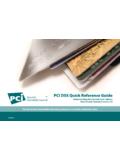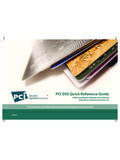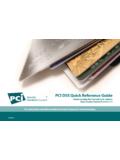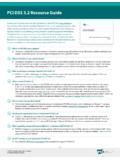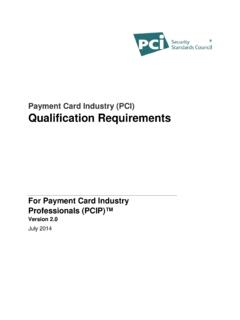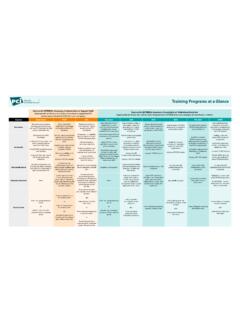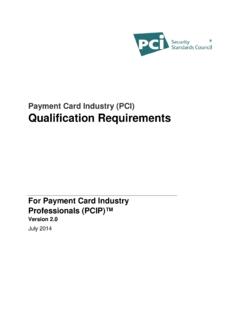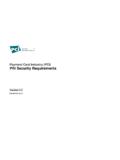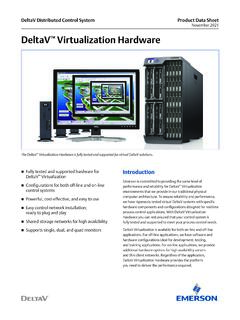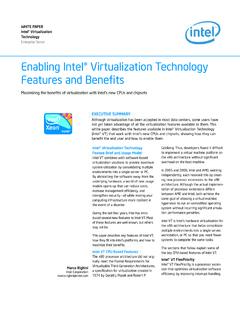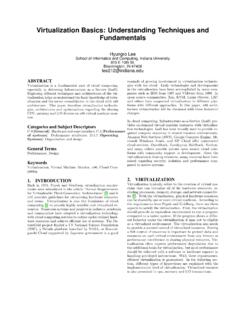Transcription of PCI DSS Virtualization Guidelines
1 Information Supplement: PCI DSS Virtualization Guidelines Standard: PCI Data Security Standard (PCI DSS) Version: Date: June 2011 Author: Virtualization Special Interest Group PCI Security Standards Council The intent of this document is to provide supplemental information. Information provided here does not replace or supersede requirements in the PCI Data Security Standard. 2 Information Supplement PCI DSS Virtualization Guidelines June 2011 Table of Contents 1 Introduction .. 3 Audience.
2 3 Intended Use .. 4 2 Virtualization Overview .. 5 Virtualization Concepts and Classes .. 5 Virtual System Components and Scoping Guidance .. 7 3 Risks for Virtualized Environments .. 10 Vulnerabilities in the Physical Environment Apply in a Virtual Environment .. 10 Hypervisor Creates New Attack Surface .. 10 Increased Complexity of Virtualized Systems and Networks .. 11 More Than One Function per Physical System .. 11 Mixing VMs of Different Trust Levels .. 11 Lack of Separation of Duties.
3 12 Dormant Virtual Machines .. 12 VM Images and Snapshots .. 13 Immaturity of Monitoring Solutions .. 13 Information Leakage between Virtual Network Segments .. 13 Information Leakage between Virtual Components .. 14 4 Recommendations .. 15 General Recommendations .. 15 Recommendations for Mixed-Mode Environments .. 20 Recommendations for Cloud Computing Environments .. 22 Guidance for Assessing Risks in Virtual Environments .. 25 5 Conclusion .. 27 6 Acknowledgments .. 28 About the PCI Security Standards Council.
4 28 7 Appendix Virtualization Considerations for PCI DSS .. 29 The intent of this document is to provide supplemental information. Information provided here does not replace or supersede requirements in the PCI Data Security Standard. 3 Information Supplement PCI DSS Virtualization Guidelines June 2011 1 Introduction Virtualization separates applications, desktops, machines, networks, data and services from their physical constraints. Virtualization is an evolving concept, encompassing a broad range of technologies, tools, and methods, and can bring significant operational benefits to organizations that choose to leverage them.
5 As with any evolving technology, however, the risks also continue to evolve and are often less understood than risks associated with more traditional technologies. The intent of this Information Supplement is to provide guidance on the use of Virtualization in accordance with the Payment Card Industry Data Security Standard (PCI DSS). For the purposes of this paper, all references are made to the PCI DSS version There are four simple principles associated with the use of Virtualization in cardholder data environments: a.
6 If Virtualization technologies are used in a cardholder data environment, PCI DSS requirements apply to those Virtualization technologies. b. Virtualization technology introduces new risks that may not be relevant to other technologies, and that must be assessed when adopting Virtualization in cardholder data environments. c. Implementations of virtual technologies can vary greatly, and entities will need to perform a thorough discovery to identify and document the unique characteristics of their particular virtualized implementation, including all interactions with payment transaction processes and payment card data.
7 D. There is no one-size-fits-all method or solution to configure virtualized environments to meet PCI DSS requirements. Specific controls and procedures will vary for each environment, according to how Virtualization is used and implemented. Audience This Information Supplement is intended for merchants and service providers who use or are considering use of Virtualization technologies in their cardholder data environment (CDE). This may also be of value for assessors reviewing environments with Virtualization as part of a PCI DSS assessment.
8 Note: This document presumes a basic level of understanding of Virtualization technologies and principles. However, an architectural-level understanding of Virtualization technologies is required to assess technical controls in virtualized environments as the nature of these environments, particularly in the areas of process isolation and virtualized networking, can be substantially different from traditional physical environments. The intent of this document is to provide supplemental information. Information provided here does not replace or supersede requirements in the PCI Data Security Standard.
9 4 Information Supplement PCI DSS Virtualization Guidelines June 2011 Intended Use This document provides supplemental guidance on the use of Virtualization technologies in cardholder data environments and does not replace or supersede PCI DSS requirements. For specific compliance criteria and audit requirements, virtualized environments should be evaluated against the criteria set forth in the PCI DSS. This document is not intended as an endorsement for any specific technologies, products or services, but rather as recognition that these technologies exist and may influence the security of payment card data.
10 The intent of this document is to provide supplemental information. Information provided here does not replace or supersede requirements in the PCI Data Security Standard. 5 Information Supplement PCI DSS Virtualization Guidelines June 2011 2 Virtualization Overview Virtualization Concepts and Classes Virtualization refers to the logical abstraction of computing resources from physical constraints. One common abstraction is referred to as a virtual machine, or VM, which takes the content of a physical machine and allows it to operate on different physical hardware and/or along with other virtual machines on the same physical hardware.

